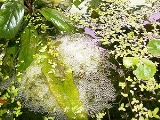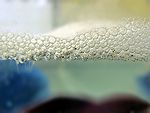
Bubble nest
Encyclopedia

Fish
Fish are a paraphyletic group of organisms that consist of all gill-bearing aquatic vertebrate animals that lack limbs with digits. Included in this definition are the living hagfish, lampreys, and cartilaginous and bony fish, as well as various extinct related groups...
species, are floating masses of bubble
Liquid bubble
A bubble is a globule of one substance in another, usually gas in a liquid.Due to the Marangoni effect, bubbles may remain intact when they reach the surface of the immersive substance.-Common examples:...
s blown with an oral secretion, saliva bubbles, and occasionally aquatic plant
Aquatic plant
Aquatic plants are plants that have adapted to living in aquatic environments. They are also referred to as hydrophytes or aquatic macrophytes. These plants require special adaptations for living submerged in water, or at the water's surface. Aquatic plants can only grow in water or in soil that is...
s, or an area for egg
Egg (biology)
An egg is an organic vessel in which an embryo first begins to develop. In most birds, reptiles, insects, molluscs, fish, and monotremes, an egg is the zygote, resulting from fertilization of the ovum, which is expelled from the body and permitted to develop outside the body until the developing...
deposit attached at the bottom. Fish that build and guard bubble nests are known as aphrophils. Aphrophils include Gourami
Gourami
Gouramis are a family, Osphronemidae, of freshwater perciform fishes. The fish are native to Asia, from Pakistan and India to the Malay Archipelago and north-easterly towards Korea. The name "gourami" is also used for fish of the families Helostomatidae and Anabantidae. "Gouramis" is an example of...
s (including Betta
Betta
Betta is a large genus of small, often colorful, freshwater ray-finned fishes in the gourami family . The type species is B. picta, the spotted betta.By far the best known Betta species, however, is B...
species) and the synbranchid eel Monopterus alba in Asia
Asia
Asia is the world's largest and most populous continent, located primarily in the eastern and northern hemispheres. It covers 8.7% of the Earth's total surface area and with approximately 3.879 billion people, it hosts 60% of the world's current human population...
, Ctenopoma
Ctenopoma
Ctenopoma is a genus of bony fishes in the Anabantidae family. It contains the following species:*Ctenopoma acutirostre Pellegrin, 1899 – spotted climbing perch, leopard bush fish*Ctenopoma ashbysmithi Banister & Bailey, 1979...
(Anabantidae), Polycentropsis (Nandidae
Nandidae
Asian leaffishes are small freshwater fishes of the Nandidae family, from Southern Asia. There are only four genera in this group.These fish usually have small heads, coloration that appears to have evolved to resemble leaves and very large protractile mouths...
), and Hepsetus odoe
Hepsetus odoe
The Hepsetus odoe, also known as the African pike or Kafue pike, is a predatory fish, and the only living member of the Family Hepsetidae.-Anatomy and Morphology:...
(the only member of Hepsetidae) in Africa
Africa
Africa is the world's second largest and second most populous continent, after Asia. At about 30.2 million km² including adjacent islands, it covers 6% of the Earth's total surface area and 20.4% of the total land area...
, and callichthyines and the electric eel
Electric eel
The electric eel , is an electric fish, and the only species of the genus Electrophorus. It is capable of generating powerful electric shocks, of up to six hundred volts, which it uses for both hunting and self-defense. It is an apex predator in its South American range...
in South America
South America
South America is a continent situated in the Western Hemisphere, mostly in the Southern Hemisphere, with a relatively small portion in the Northern Hemisphere. The continent is also considered a subcontinent of the Americas. It is bordered on the west by the Pacific Ocean and on the north and east...
. Most, if not all, fish that construct floating bubble nests live in tropical, oxygen-depleted standing waters. Also, some sunfish
Centrarchidae
The sunfishes are a family of freshwater ray-finned fish belonging to the order Perciformes. The type genus is Centrarchus . The family's 27 species includes many fishes familiar to North Americans, including the rock bass, largemouth bass, bluegill, pumpkinseed, and crappies...
and cichlid
Cichlid
Cichlids are fishes from the family Cichlidae in the order Perciformes. Cichlids are members of a group known as the Labroidei along with the wrasses , damselfish , and surfperches . This family is both large and diverse. At least 1,300 species have been scientifically described, making it one of...
s create bubblenests. Anabantidae are the most commonly recognized family of bubblenest makers. The nests are constructed as a place for fertilized eggs to be deposited while incubating and guarded by the male until the fry hatch.
Construction

Various things have been shown to stimulate bubble nest construction, such as quick temperature changes, barometric
Barometer
A barometer is a scientific instrument used in meteorology to measure atmospheric pressure. Pressure tendency can forecast short term changes in the weather...
changes, fluctuations in rainfall, materials in the tank, and presence of other males or females.
The nests are built by the male (sometimes females) and their size, position and shape depends on the species
Species
In biology, a species is one of the basic units of biological classification and a taxonomic rank. A species is often defined as a group of organisms capable of interbreeding and producing fertile offspring. While in many cases this definition is adequate, more precise or differing measures are...
. The nest is most often made at the water surface, sometimes among floating plants, whether natural or artificial. Occasionally, every object floating will have bubbles on it.
Bubble nests created by male betta/Siamese Fighting Fish
Siamese fighting fish
The Siamese fighting fish , also known as the betta , is a popular species of freshwater aquarium fish. The name of the genus is derived from ikan bettah, taken from a local dialect of Malay...
(Betta splendens) are made from air bubbles
Liquid bubble
A bubble is a globule of one substance in another, usually gas in a liquid.Due to the Marangoni effect, bubbles may remain intact when they reach the surface of the immersive substance.-Common examples:...
coated with saliva
Saliva
Saliva , referred to in various contexts as spit, spittle, drivel, drool, or slobber, is the watery substance produced in the mouths of humans and most other animals. Saliva is a component of oral fluid. In mammals, saliva is produced in and secreted from the three pairs of major salivary glands,...
to increase durability. This makes a louder noise than regular breathing and is often frantic behavior.
Bubblenests and breeding
All species of bubble nesters continue parental care after construction of the floating bubble nest and spawning. After spawningSpawn (biology)
Spawn refers to the eggs and sperm released or deposited, usually into water, by aquatic animals. As a verb, spawn refers to the process of releasing the eggs and sperm, also called spawning...
, the eggs float up into the bubble nest, or are carried there held in the mouth by the male, as if he were eating them. The male lodges them in the nest to protect them, and then protects the brood by chasing away the female and any other intruders, concentrating on the eggs in the nest, retrieving any eggs or fry that fall from the nest and keeping the nest in repair. The male will guard the eggs constantly until the fry hatch in 24–48 hours and be suspended from the nest. For the next few weeks, they will stay nearby being tended by the male.
External links
- http://video.google.com/videoplay?docid=-5283130493605685802 - A video of two Siamese Fighting FishSiamese fighting fishThe Siamese fighting fish , also known as the betta , is a popular species of freshwater aquarium fish. The name of the genus is derived from ikan bettah, taken from a local dialect of Malay...
spawning. The male can be seen carrying eggs up to the bubblenest. - Bubble nest building
- Function of bubble nests

